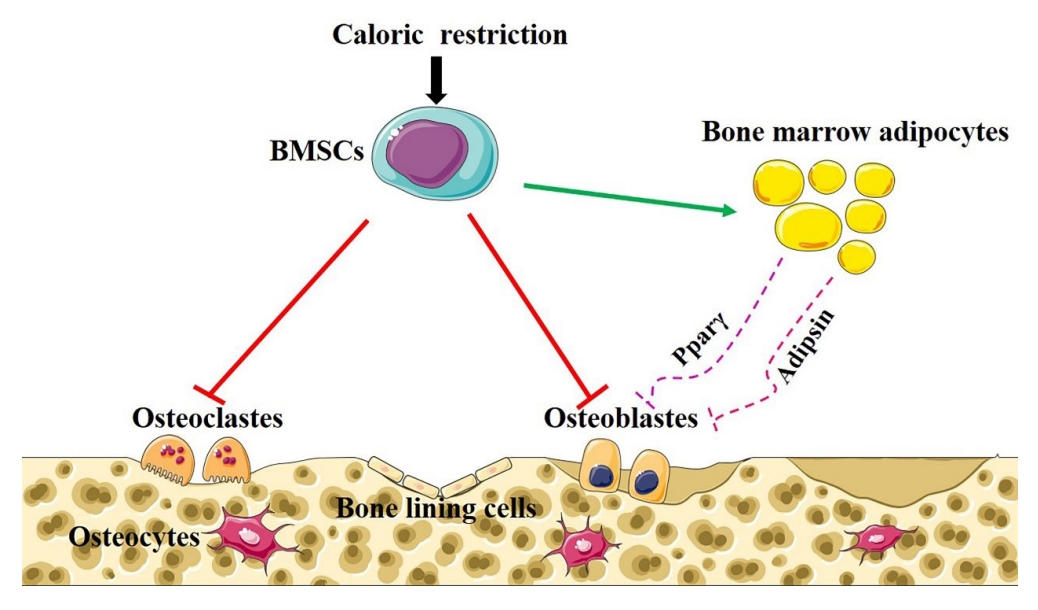Search
- Page Path
- HOME > Search
- Calcium & bone metabolism
- New Insights into Calorie Restriction Induced Bone Loss
- Linyi Liu, Clifford J. Rosen
- Endocrinol Metab. 2023;38(2):203-213. Published online April 27, 2023
- DOI: https://doi.org/10.3803/EnM.2023.1673

- 3,341 View
- 176 Download
- 3 Web of Science
- 3 Crossref
-
 Abstract
Abstract
 PDF
PDF PubReader
PubReader  ePub
ePub - Caloric restriction (CR) is now a popular lifestyle choice due to its ability in experimental animals to improve lifespan, reduce body weight, and lessen oxidative stress. However, more and more emerging evidence suggests this treatment requires careful consideration because of its detrimental effects on the skeletal system. Experimental and clinical studies show that CR can suppress bone growth and raise the risk of fracture, but the specific mechanisms are poorly understood. Reduced mechanical loading has long been thought to be the primary cause of weight loss-induced bone loss from calorie restriction. Despite fat loss in peripheral depots with calorie restriction, bone marrow adipose tissue (BMAT) increases, and this may play a significant role in this pathological process. Here, we update recent advances in our understanding of the effects of CR on the skeleton, the possible pathogenic role of BMAT in CR-induced bone loss, and some strategies to mitigate any potential side effects on the skeletal system.
-
Citations
Citations to this article as recorded by- Obesity, diabetes and risk of bone fragility: How BMAT behavior is affected by metabolic disturbances and its influence on bone health
Gregório Corrêa Guimarães, João Bosco Costa Coelho, João Gabriel Oliveira Silva, Ana Carolina Chalfun de Sant’Ana, Cássia Alves Carrilho de Sá, Júlia Marques Moreno, Lívia Marçal Reis, Camila Souza de Oliveira Guimarães
Osteoporosis International.2024; 35(4): 575. CrossRef - Bone Marrow Adipose Tissue Is Not Required for Reconstitution of the Immune System Following Irradiation in Male Mice
Jessica A. Keune, Carmen P. Wong, Adam J. Branscum, Scott A. Menn, Urszula T. Iwaniec, Russell T. Turner
International Journal of Molecular Sciences.2024; 25(4): 1980. CrossRef - Dietary restriction plus exercise change gene expression of Cxcl12 abundant reticular cells in female mice
Aoi Ikedo, Yuuki Imai
Journal of Bone and Mineral Metabolism.2024;[Epub] CrossRef
- Obesity, diabetes and risk of bone fragility: How BMAT behavior is affected by metabolic disturbances and its influence on bone health

- Bone Metabolism
- Short-Term Caloric Restriction Does Not Reduce Bone Mineral Density in Rats with Early Type 2 Diabetes
- Yun Kyung Jeon, Won Jin Kim, Myung Jun Shin, Hae-Young Chung, Sang Soo Kim, Bo Hyun Kim, Seong-Jang Kim, Yong Ki Kim, In Joo Kim
- Endocrinol Metab. 2014;29(1):70-76. Published online March 14, 2014
- DOI: https://doi.org/10.3803/EnM.2014.29.1.70
- 3,549 View
- 27 Download
- 5 Web of Science
- 4 Crossref
-
 Abstract
Abstract
 PDF
PDF PubReader
PubReader Background The effect of caloric restriction (CR) in the setting of diabetes on bone metabolism has not yet been fully studied. The aim of this study is to determine if short-term CR alters bone mass and metabolism in Otsuka Long-Evans Tokushima fatty (OLETF) rats, an animal model of type 2 diabetes.
Methods Four groups (
n =5) were created: OLETF rats with foodad libitum (AL), OLETF rats with CR, Long-Evans Tokusima Otsuka (LETO) rats with food AL, and LETO rats with CR. The CR condition was imposed on 24-week-old male rats using a 40% calorie reduction for 4 weeks. The effect of CR on femoral bone mineral density (BMD) was assessed by dual-energy X-ray absorptiometry. Serum markers were measured by immunoassay.Results After 4 weeks of CR, body weight decreased in both strains. The BMD decreased in LETO rats and was maintained in OLETF rats. After adjustment for body weight, BMD remained lower in LETO rats (
P =0.017) but not OLETF rats (P =0.410). Bone-specific alkaline phosphatase levels decreased in LETO rats (P =0.025) but not in OLEFT rats (P =0.347). Serum leptin levels were reduced after CR in both strains, but hyperleptinemia remained in OLETF rats (P =0.009). CR increased 25-hydroxyvitamin D levels in OLETF rats (P =0.009) but not in LETO rats (P =0.117). Additionally, interleukin-6 and tumor necrosis factor-α levels decreased only in OLETF rats (P =0.009).Conclusion Short-term CR and related weight loss were associated with decreases of femoral BMD in LETO rats while BMD was maintained in OLETF rats. Short-term CR may not alter bone mass and metabolism in type 2 diabetic rats.
-
Citations
Citations to this article as recorded by- Changes in bone mass associated with obesity and weight loss in humans: Applicability of animal models
Vivi F.H. Jensen, Anne-Marie Mølck, Majken Dalgaard, Fiona E. McGuigan, Kristina E. Akesson
Bone.2021; 145: 115781. CrossRef - Short‐term caloric restriction induced bone loss in both axial and appendicular bones by increasing adiponectin
Junxiong Zhu, Can Liu, Jialin Jia, Chenggui Zhang, Wanqiong Yuan, Huijie Leng, Yingsheng Xu, Chunli Song
Annals of the New York Academy of Sciences.2020; 1474(1): 47. CrossRef - Dietary restrictions, bone density, and bone quality
Tsang‐hai Huang, Gene P. Ables
Annals of the New York Academy of Sciences.2016; 1363(1): 26. CrossRef - Articles in 'Endocrinology and Metabolism' in 2014
Won-Young Lee
Endocrinology and Metabolism.2015; 30(1): 47. CrossRef
- Changes in bone mass associated with obesity and weight loss in humans: Applicability of animal models


 KES
KES

 First
First Prev
Prev



